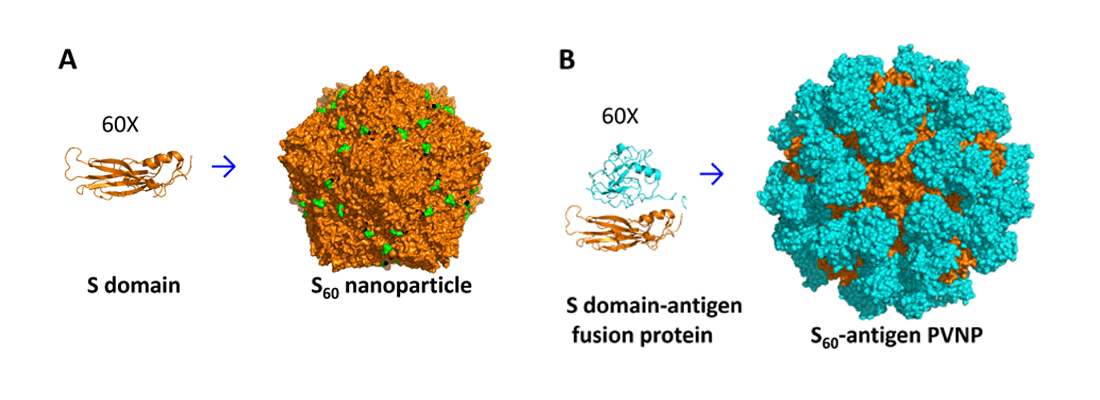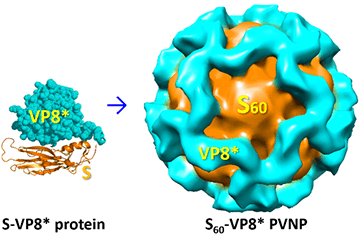Current Projects
Among the subviral particles that we have invented, an innovative nanoparticle, called S60 nanoparticle, self-assembles by 60 norovirus (NoV) shell (S) domains via homotypic interactions (Figure 1A) is recently created. It structurally resembles the inner shell of NoV capsid with 60 S domain C-termini extending flexibly on the surface, providing excellent fusion sites to display viral neutralizing antigens for strengthened immune responses. When a viral antigen is fused to the S domain C-terminus, the fusion proteins self-assemble into chimeric pseudovirus nanoparticles (PVNPs) that consists of a S60 nanoparticle inner shell and 60 surface-displayed viral antigens (Figure 1B).

Figure 1. The self-formation principle of the S60 nanoparticle and the S60-antigen PVNPs. (Left panel, A) 60 NoV S domains (left, orange) self-assemble into the S60 nanoparticle (right) with 60 exposed C-termini (green). (Right panel, B) Fusion of an antigen (left, cyan) to the S domain C-terminus leads to 60 antigens being displayed on the S60 nanoparticle, forming the S60-antigen PVNP (right).
Using this patented technology, we have created two unique PVNPs that display a) the receptor binding VP8* antigens of rotavirus (RV) spike proteins, named S60-VP8* PVNP, and b) the receptor binding HA1 proteins of influenza virus (IV) hemagglutinins, known as S60-HA1 PVNP, respectively. These two PVNPs have been shown to be easily produced using a recombinant protein expression system, highly stable at a wide range of temperatures, and immunogenic towards the displayed antigens, eliciting high antibody titers that block viral receptor binding functions, and thus inhibit infections of corresponding viral pathogens. Therefore, these two PVNPs are promising vaccine candidates that are currently under further development in our laboratory against the RVs and IVs, respectively. This core invention of the laboratory has put us at the forefront of subunit vaccine development against various pathogens.
Our nanoparticle vaccine technology represents a novel approach for development of new interventions to control and prevent infectious illnesses. After proofs of concept through successes of the above mentioned two vaccines, our long-term goals are to apply these principles and technologies to other viral and/or non-viral pathogens to develop more vaccines to fight many more infectious diseases to meet the wide and urgent needs of global public health.
Project 1: Development of a nanoparticle-based multivalent Rotavirus vaccine for broad efficacy
Rotaviruses (RVs) cause severe diarrhea in young children. While the current live oral RV vaccines are highly effective in developed nations, they are less effective in developing countries, where RV infections still claim ~200,000 lives annually and cause enormous morbidity.
Reasons for reduced efficacy in developing countries include microbiota dysbiosis, concurrent use of other oral vaccines, enterovirus infections, and malnutrition; all factors that alter the intestinal microbiome and disrupt the health of the gut. Parenteral RV vaccines are thus proposed as a mean to bypass this problem and improve vaccine effectiveness in the developing world.
Our innovative S60-VP8* pseudovirus nanoparticle (PVNP, Figure 2) RV vaccine will address the need for a parenteral RV vaccine. The bioengineered S60-VP8* nanoparticles are self-assembled, easily produced, highly stable, and extremely immunogenic, and hence, an excellent RV vaccine candidate. The nonreplicating nature of this nanoparticle vaccine and its parenteral delivery method will avoid the intussusception risk of the oral RV vaccines for better safety, whereas its easy production offers improved cost-effectiveness. Each S60-VP8* nanoparticle contains a 60-valent norovirus inner shell and 60 surface-displayed RV VP8* antigens. VP8* is the RV receptor-binding domain; antibodies elicited by natural RV infections are largely VP8*-specific and neutralizing, making VP8* an ideal vaccine target. As a proof of concept, we have demonstrated that the S60-VP8* nanoparticle displaying the predominant P[8] RV VP8* is highly immunogenic, elicits neutralizing antibodies, and protects mice from RV infection.
In this project we will produce a cocktail S60-VP8* nanoparticle vaccine displaying RV VP8*s of the globally predominant P[8], P[4], P[6], and P[11] RVs and define the safety, broad immunogenicity, and the breath of cross protective efficacy of this cocktail vaccine.

Figure 2. The self-assembly of the S60-VP8* nanoparticles. Fusion of an RV VP8* antigen (left, cyan) to the S domain (left, orange) C-terminus leads to 60 VP8* antigens being displayed on each S60 nanoparticle, forming the S60-VP8* PVNP (right).
Funding
- Title: A nanoparticle-based multivalent vaccine against rotavirus
Source: NIH/NIAID, R56, Grant #: 1 R56 AI148426-01A1
Role: Principal Investigator
Project Period: 08/2020 - 07/2022 - Title: A pseudovirus nanoparticle-based multivalent vaccine against rotavirus
Source: GAP Funding, Cincinnati Children’s Hospital Medical Center
Role: Principal Investigator
Project Period: 10/2020 - 09/2022
Project 2: Development of a nanoparticle-based quadrivalent influenza vaccine
Influenza viruses (IVs) cause epidemic, lethal influenza (flu). The effectiveness of conventional flu vaccines remains low; as a result, seasonal flu still claims 250,000-500,000 lives annually, even with the implementation of current vaccines. Hence, flu remains a major public health threat, calling urgently for improved flu vaccine tactics.
To meet this public health need, we have generated innovative S60-HA1 PVNPs as a new flu vaccine candidate (Figure 3). Each PVNP contains an icosahedral core of an S60 nanoparticle that is self-assembled by 60 modified norovirus capsid shell (S) domains with exposed C-termini. When an IV HA1 antigen is fused to the S domain C-terminus, the fusion proteins self-assemble into the S60-HA1 PVNPs with 60 exposed HA1s forming 20 trimers. HA1 is the distal head of IV hemagglutinin (HA) that binds host receptors to initiate IV infections; it is a major IV neutralizing antigen and an ideal vaccine target. The S60-HA1 PVNPs are easily produced and highly stable. The PVNP-displayed HA1s retain original receptor-binding specificity and hemagglutination ability as their parental IVs. They are highly immunogenic, eliciting high titers of HA1-specific antibody in mice with strong ability of hemagglutination inhibition (HI). Importantly, the PVNP vaccine protects mice from IV challenge, supporting that the S60-HA1 PVNPs are a promising flu vaccine candidate.
A key factor contributing to the low efficacy of conventional flu vaccines is their altered antigenicity, resulting from mutations of vaccine strains, mostly in the HA1 regions, acquired from adaption to eggs or cell culture during vaccine production. Thus, our PVNP vaccine with original HA1 sequences and authentic receptor-binding sites (RBSs) will lead to high efficacy.
Evolutionary distinct IVs often share conserved RBSs, making them an antigenic supersite eliciting broadly neutralizing antibody. Thus, our PVNP vaccine, targeting HA1s with the conserved RBSs, may result in long lasting effectiveness. In addition, the PVNP is non-replicating, offering good vaccine safety, while their easy production will reduce vaccine manufacturing cost and time.
In this project, we will produce four types of PVNPs, displaying the HA1 antigens of the four predominant IV subtypes/lineages as a quadrivalent flu vaccine for high and broad protective efficacy.

Figure 3. The self-formation of the S60-HA1 PVNPs. Fusion of an HA1 antigen (cyan) to the S domain C-terminus (left) leads to self-assembly of S60-HA1 PVNPs (right) with 60 HA1 antigens on the surface forming 20 HA1-trimers.
Funding
- Title: A pseudovirus nanoparticle-based quadrivalent influenza vaccine
Source: Innovation Fund of Cincinnati Children’s Hospital Medical Center
Role: Principal Investigator
Project Period: 12/2020 - 08/2022
Project 3: Development of a nanoparticle-based vaccines against other pathogens.
The S60 nanoparticle technology is also being applied to other viral and non-viral pathogens for novel vaccine development. We are generating various PVNPs, each displaying neutralizing antigens of other pathogens, including those of the newly emerged severe acute respiratory syndrome coronavirus 2 (SARS-CoV-2) that causes the ongoing coronavirus disease-19 (COVID-19) pandemic, the SARS-CoV-1, the Middle East respiratory syndrome coronavirus (MERS-CoV), the Mycobacterium tuberculosis that causes tuberculosis (TB), and the Plasmodium parasite that causes malaria. These vaccine developments are still at their early stages.
Funding
- Title: Construction of SARS-CoV-2 pseudovirus nanoparticles as a COVID-19 vaccine candidate
Source: COVID-19 Research Innovation and Pilot Grant, Cincinnati Children’s Hospital Medical Center
Role: Principal Investigator
Project Period: 05/2020 - 04/2022



